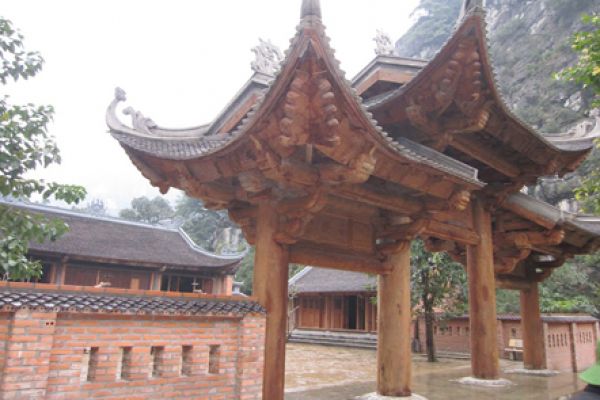Located in Nham Bieu hamlet, Huong Ho commune, Huong Tra district, Thua Thien-Hue province, Huyen Khong Son Tra belongs to the Nam Tong Buddhism school. The pagoda, surrounded by bamboo trees, was built in 1973 by bonzes Vien Minh, Tinh Phap, Tri Tham and Tan Can, and originally stood in Phu Loc District’s Loc Hai Commune. It was moved in 1978 to its current place in Huong Tra District’s Huong Ho Commune by a monk, the Most Venerable Gioi Duc, who headed the pagoda until 1983 and who was succeeded by the Most Venerable Phap Tong. Upon entering the grounds through a looming gate, you can see a large rock painted with calligraphic poems that have profound spiritual meaning, according to the monks and nuns who live on the pagoda grounds. Once you are inside the area, you feel engulfed by the serenity and simple majesty of its scenery. Thanks to the care of the monks and nuns, the gardens near the Huyen Khong Pagoda are wonderfully unregimented, reflecting the traditionally subtle garden architecture of Hue. Many rare species of flowers perfume the entire area. There, orchids, old roots of apricot trees and elegant conifer bonsais contrast with the moss-covered ground. Birds can be heard singing in the forest behind the area, where a centuries-old tree stands near a statue of a Buddhist monk standing in deep contemplation. Near the path to the main pagoda is a lake covered with water lilies and lotus flowers. Small one-floor cottages made of bamboo and rattan along the lake display hundreds of poems, proverbs and philosophical sentences written in calligraphy. Most of these works were reportedly composed by the pagoda’s monks, guest monks and even a few visitors inspired by the area’s natural beauty, pure air and seclusion. Surrounded by such an atmosphere, visitors feel lost in a world of poems and art. They are especially impressed after seeing the many beautiful calligraphic works of the pagoda's verger, Most Venerable Gioi Duc (his Buddhist name is Minh Duc Trieu Tam Anh), displayed at the Pagoda. Minh Duc Trieu Tam Anh whose pen-name is Monk Gioi Duc, is one of the founders of Huyen Khong Pagoda. He is an expert on literature and poetry, and has published poems and articles on Buddhism in the Song Huong magazine and other local newspapers. He has also become well known as a famous Vietnamese calligrapher during the late 20th century and the early 21st century. Further information:  Bas-reliefs featuring images of the four supernatural creatures – dragon, unicorn, tortoise and phoenix – in two main colours of blue and white, demonstrate typical cultural features of the Hue Imperial Palace. Visitors can see calligraphy works by many other calligraphers in Hue, which are displayed at a thatched cottage named May Tia (purple cloud, sometimes called Phong Truc Am). Poets and calligraphers meet at the cottage to recite poems and create calligraphy works
Bas-reliefs featuring images of the four supernatural creatures – dragon, unicorn, tortoise and phoenix – in two main colours of blue and white, demonstrate typical cultural features of the Hue Imperial Palace. Visitors can see calligraphy works by many other calligraphers in Hue, which are displayed at a thatched cottage named May Tia (purple cloud, sometimes called Phong Truc Am). Poets and calligraphers meet at the cottage to recite poems and create calligraphy works
Overlooking the top of the hill, to the left of the pagoda lies “Qua Thien Duong” (the dining room) and “Chung Hoa Duong” (the activity hall). In front of the pagoda lies Tang Xa and Tue Hoc Duong (the study rooms). Residents of the pagoda have planted 60,000 pine trees, creating a 56-hectare evergreen forest at the foot and up the slope of Hon Vuon - a mountain with thousands of pine trees called Van Tung Son by locals. Almost 20 monks who study at the Huyen Khong Buddhism Institute can mediate or practice Buddhist contemplation at the cottages scattered in the forest. Visiting Huyen Khong, visitors can not only enjoy the tranquil and warm atmosphere but also talk to experienced monks about the art of calligraphy, painting, photography and poetry. Right from the beginning of a visit to Huyen Khong Son Thuong Pagoda, visitors will have the feeling of being in a heaven on earth; enjoying the special moments of walking in the gently blowing winds, breathing in the fragrance of lotus flowers and hearing the pagoda's bell ringing from far and wide, bringing the hearers to a state of complete peace of mind.
Right from the beginning of a visit to Huyen Khong Son Thuong Pagoda, visitors will have the feeling of being in a heaven on earth; enjoying the special moments of walking in the gently blowing winds, breathing in the fragrance of lotus flowers and hearing the pagoda's bell ringing from far and wide, bringing the hearers to a state of complete peace of mind.
(Source: Travellive) |



